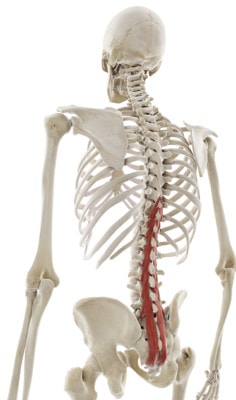My Back Gets Tight When Running, What Does this Mean?

Multifidus muscles. SciePro/Shutterstock
What does it mean when your back gets tight when running? I’m travelling this weekend and my back has been tight these past few days. I know why, but I thought my readers might enjoy learning why my back is tight and why their back may get tight with running.
As I’ve blogged before, the back has two stability systems-passive and active. The first is made up of passive elements like ligaments, facet joints, and discs. Each of these limit motion between the back bones when there’s way too much. However for most activities, it’s the muscles that do most of the stability work. Think of these important muscles like an active shock absorber system on a fancy car-they adjust to your motion and keep the back bones aligned with great precision. Why is this important? Realize that when the back bones aren’t kept aligned as you move, the joints, disc, and nerves that live between the bones can get pinched or slowly damaged. So what does all of this have to do with your back being tight? When these small stability muscles (a.k.a. multifidus-see the dark red muscles above) go off-line, the big back muscles try to take over and do something they’re not designed to do-they try to stabilize the spine. Since they aren’t in a good place to stabilize the individual back bones they quickly tire and go into spasm. What can take these multifidus muscles out of the stability picture? An irritated nerve in the low back is usually the culprit. You may not be aware of the nerve being a problem other than your back gets tight when you’re active. What can be done? First you have to calm down the irritated nerve. We usually do this with an injection of the patient’s own growth factors around the irritated nerve combined with specialized physical therapy. Once the deep stabilizing muscles come back on-line, there’s no need for the big back muscles to get tight so they can relax and let the small muscles stabilize the spine bones. There’s a lot more on this topic in our practice’s e-book, Orthopedics 2.0.
The upshot? Your back is probably too tight because of little stability muscles you’ve likely never heard of. Learning more about these muscles and helping them get going again are key to being able to run without low back tightness getting in your way!

If you have questions or comments about this blog post, please email us at [email protected]
NOTE: This blog post provides general information to help the reader better understand regenerative medicine, musculoskeletal health, and related subjects. All content provided in this blog, website, or any linked materials, including text, graphics, images, patient profiles, outcomes, and information, are not intended and should not be considered or used as a substitute for medical advice, diagnosis, or treatment. Please always consult with a professional and certified healthcare provider to discuss if a treatment is right for you.
